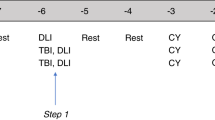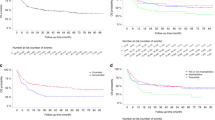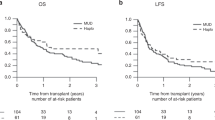Abstract
Allogeneic transplantation of hematopoietic cells from an HLA-compatible donor has been used to treat hematologic malignancies. Allogeneic transplantation not only replaces the marrow affected by the disease, but exerts an immune graft-versus-tumor (GVT) effect mediated by donor lymphocytes. The development of nonmyeloablative conditioning regimens before allogeneic transplantation has allowed this therapy to be used in elderly and disabled patients. An allogeneic GVT effect is observed in a proportion of patients with renal, breast, colorectal, ovarian, and pancreatic cancer treated with allogeneic transplantation. In general, the tumor response is associated with the development of acute and chronic graft-versus-host disease. Further improvements will depend on the identification of the antigen targets of GVT, and on reduction of the toxicity of the procedure. Targeted therapies may complement the immune effect of allogeneic transplantation. We present updated results from the literature and data recently placed on file at the European Bone Marrow Transplantation Solid Tumors Working Party.
Key Points
-
Allogeneic stem-cell transplantation from a HLA-compatible sibling donor or from a matched unrelated donor is a beneficial treatment for patients with relapsed and high-risk hematological malignancies
-
Radiotherapy and/or chemotherapy are administered before allotransplant for cytoreduction of the disease and for ablation of the patient's immune system, thus allowing engraftment of infused cells; the newly introduced nonmyeloablative or reduced-intensity regimens are purely immunosuppressive
-
T cells in the infused transplant facilitate engraftment and exert an immune attack on the patient's leukemia/tumor cells, the so-called “graft-versus-leukemia/tumor” effect
-
Retrospective analyses and prospective pilot studies demonstrate a graft-versus-tumor effect in solid tumors, particularly in advanced, clear-cell renal cancer, but also in breast, ovarian, colorectal and pancreatic carcinoma, and soft-tissue sarcoma
-
The mechanisms of the graft-versus-tumor effect are still poorly understood: an immune reaction by donor T cells against minor histocompatibility antigens or tumor-associated antigens is most probably involved
-
Allogeneic transplantation in renal cancer and other solid tumors should be considered a developmental therapy until definitive proof of a clinical benefit is achieved by current studies
This is a preview of subscription content, access via your institution
Access options
Subscribe to this journal
Receive 12 print issues and online access
$209.00 per year
only $17.42 per issue
Buy this article
- Purchase on Springer Link
- Instant access to full article PDF
Prices may be subject to local taxes which are calculated during checkout

Similar content being viewed by others
References
Copelan EA (2006) Hematopoietic stem-cell transplantation. N Engl J Med 354: 1813–1826
Eibl B et al. (1996) Evidence for a graft-versus-tumor effect in a patient treated with marrow ablative chemotherapy and allogeneic bone marrow transplantation for breast cancer. Blood 88: 1501–1508
Ueno NT et al. (1998) Allogeneic peripheral-blood progenitor-cell transplantation for poor-risk patients with metastatic breast cancer. J Clin Oncol 16: 986–993
Childs R et al. (2000) Regression of metastatic renal-cell carcinoma after nonmyeloablative allogeneic peripheral-blood stem-cell transplantation. N Engl J Med 343: 750–758
Bregni M et al. (2002) Nonmyeloablative conditioning followed by hematopoietic cell allografting and donor lymphocyte infusions for patients with metastatic renal and breast cancer. Blood 99: 4234–4236
Carella AM et al. (2002) Combined use of autografting and non-myeloablative allografting for the treatment of hematologic malignancies and metastatic breast cancer. Cancer Treat Res 110: 101–112
Ueno NT et al. (2003) Rapid induction of complete donor chimerism by the use of a reduced-intensity conditioning regimen composed of fludarabine and melphalan in allogeneic stem cell transplantation for metastatic solid tumors. Blood 102: 3829–3836
Blaise D et al. (2004) Reduced-intensity preparative regimen and allogeneic stem cell transplantation for advanced solid tumors. Blood 103: 435–441
Bishop MR et al. (2004) Allogeneic lymphocytes induce tumor regression of advanced metastatic breast cancer. J Clin Oncol 22: 3886–3892
Khouri IF et al. (1998) Transplant-lite: induction of graft-versus-malignancy using fludarabine-based nonablative chemotherapy and allogeneic blood progenitor-cell transplantation as treatment for lymphoid malignancies. J Clin Oncol 16: 2817–2824
Sandmaier B et al. (2007) Reduced intensity conditioning for allogeneic hematopoietic cell transplantation: current perspectives. Biol Blood Marrow Transplant 13: 87–97
Slavin S et al. (2004) Nonmyeloablative stem cell transplantation: reduced-intensity conditioning for cancer immunotherapy: from bench to patient bedside. Semin Oncol 31: 4–21
Niederwieser D et al. (2003) Low-dose total body irradiation (TBI) and fludarabine followed by hematopoietic cell transplantation (HCT) from HLA-matched or mismatched unrelated donors and postgrafting immunosuppression with cyclosporine and mycophenolate mofetil (MMF) can induce durable complete chimerism and sustained remissions in patients with hematological diseases. Blood 101: 1620–1629
Morecki S et al. (1997) Induction of graft vs tumor effect in a murine model of mammary adenocarcinoma. Int J Cancer 71: 59–63
Morecki S et al. (1998) Allogeneic cell therapy for a murine mammary carcinoma. Cancer Res 58: 3891–3895
Morecki S et al. (2001) Cell therapy with pre-immunized effector cells mismatched for minor histocompatible antigens, in the treatment of a murine mammary carcinoma. J Immunother 24: 114–121
Kolb HJ et al. (1995) Graft-versus-leukemia effect of donor lymphocyte transfusions in marrow grafted patients. European Group for Blood and Marrow Transplantation Working Party Chronic Leukemia. Blood 86: 2041–2050
Mackinnon S et al. (1995) Adoptive immunotherapy evaluating escalating doses of donor leukocytes for relapse of chronic myeloid leukemia after bone marrow transplantation: separation of graft-versus-leukemia responses from graft-versus-host disease. Blood 86: 1261–1268
Porter DL et al. (1996) Adoptive immunotherapy with donor mononuclear cell infusions to treat relapse of acute leukemia or myelodysplasia after allogeneic bone marrow transplantation. Bone Marrow Transplant 18: 975–980
Marijt W et al. (2003) Hematopoiesis-restricted minor histocompatibility antigens HA-1- or HA-2-specific T cells can induce complete remissions of relapsed leukemia. Proc Natl Acad Sci USA 100: 2742–2747
Klein C et al. (2002) The hematopoietic system-specific minor histocompatibility antigen HA-1 shows aberrant expression in epithelial cancer cells. J Exp Med 196: 359–368
Tykodi SS et al. (2004) Allogeneic hematopoietic cell transplantation for metastatic renal cell carcinoma after nonmyeloablative conditioning: toxicity, clinical response, and immunological response to minor histocompatibility antigens. Clin Cancer Res 10: 7799–7811
Rosenberg SA (2001) Progress in human tumour immunology and immunotherapy. Nature 411: 380–384
Rosenberg SA (1999) A new era for cancer immunotherapy based on the genes that encode cancer antigens. Immunity 10: 281–287
Rosenberg SA et al. (1986) A new approach to the adoptive immunotherapy of cancer with tumor-infiltrating lymphocytes. Science 233: 1318–1321
Kawakami Y et al. (1994) Identification of a human melanoma antigen recognized by tumor-infiltrating lymphocytes associated with in vivo tumor rejection. Proc Natl Acad Sci USA 91: 6458–6462
Kawakami Y et al. (1994) Cloning of the gene coding for a shared human melanoma antigen recognized by autologous T cells infiltrating into tumor. Proc Natl Acad Sci USA 91: 3515–3519
Dudley ME et al. (2005) Adoptive cell transfer therapy following non-myeloablative but lymphodepleting chemotherapy for the treatment of patients with refractory metastatic melanoma. J Clin Oncol 23: 2346–2357
Kausche S et al. (2006) Superior antitumor in vitro responses of allogeneic matched sibling compared to autologous patient CD8+ T cells. Cancer Res 66: 11447–11454
Jantzer P and Schendel DJ (1998) Human renal cell carcinoma antigen-specific CTLs: antigen-driven selection and long-term persistence in vivo. Cancer Res 58: 3078–3086
Gaugler B et al. (1996) A new gene coding for an antigen recognized by autologous cytolytic T lymphocytes on a human renal carcinoma. Immunogenetics 44: 323–330
Brändle D et al. (1996) A mutated HLA-A2 molecule recognized by autologous cytotoxic T lymphocytes on a human renal cell carcinoma. J Exp Med 183: 2501–2508
Gaudin C et al. (1999) An hsp70-2 mutation recognized by CTL on a human renal cell carcinoma. J Immunol 162: 1730–1738
Probst-Kepper M et al. (2001) An alternative open reading frame of the human macrophage colony-stimulating factor gene is independently translated and codes for an antigenic peptide of 14 amino acids recognized by tumor-infiltrating CD8 T lymphocytes. J Exp Med 193: 1189–1198
Hanada K et al. (2004) Immune recognition of a human renal cancer antigen through post-translational protein splicing. Nature 427: 252–256
Carnevale-Schianca F et al. (2006) Allogeneic nonmyeloablative hematopoietic cell transplantation in metastatic colon cancer: tumor-specific T-cells directed to a tumor-associated antigen are generated in vivo during GVHD. Blood 107: 3795–3803
Warren EH et al. (1998) Cytotoxic T-lymphocyte-defined human minor histocompatibility antigens with a restricted tissue distribution. Blood 91: 2197–2207
Tso CL et al. (2001) Induction of G250-targeted and T-cell-mediated antitumor activity against renal cell carcinoma was achieved by using a chimeric fusion protein consisting of G250 and granulocyte/monocyte-colony stimulating factor. Cancer Res 61: 7925–7933
Mukouyama H et al. (2004) Generation of kidney cancer-specific antitumor immune responses using peripheral blood monocytes transduced with a recombinant adenovirus encoding carbonic anhydrase 9. Clin Cancer Res 10: 1421–1429
Aoudjhane M et al. (2005) Comparative outcome of reduced intensity and myeloablative conditioning regimen in HLA identical sibling allogeneic haematopoietic stem cell transplantation for patients older than 50 years of age with acute myeloblastic leukaemia: a retrospective survey from the Acute Leukemia Working Party (ALWP) of the European group for Blood and Marrow Transplantation (EBMT). Leukemia 19: 2304–2312
Mohty M et al. (2003) Graft-versus-host disease following allogeneic transplantation from HLA-identical sibling with antithymocyte globulin-based reduced-intensity preparative regimen. Blood 102: 470–476
Motzer RJ et al. (1996) Renal-cell carcinoma. N Engl J Med 335: 865–875
Rosenberg SA et al. (1998) Durability of complete responses in patients with metastatic cancer treated with high-dose interleukin-2; identification of the antigens mediating response. Ann Surg 228: 307–319
Coppin C et al. Immunotherapy for advanced renal cell cancer. Cochrane Database of Systematic Reviews 2000, Issue 3 Art. No.: CDO001425 10.1002/14651858.CD001425.pub2
Bregni M et al. (2006) The second international meeting on allogeneic transplantation in solid tumors. Bone Marrow Transplant 38: 527–537
Pedrazzoli P et al. (2002) Allogeneic blood stem cell transplantation after a reduced-intensity, preparative regimen: a pilot study in patients with refractory malignancies. Cancer 94: 2409–2415
Rini BI et al. (2002) Allogeneic stem-cell transplantation of renal cell cancer after nonmyeloablative chemotherapy: feasibility, engraftment and clinical results. J Clin Oncol 20: 2017–2024
Hentschke P et al. (2003) Low-intensity conditioning and hematopoietic stem cell transplantation in patients with renal and colon carcinoma. Bone Marrow Transplant 31: 253–261
Baron F et al. (2003) Non-myeloablative stem cell transplantation with low-dose body irradiation and fludarabine for metastatic renal cell carcinoma. Hematologica 88: 479–480
Nakagawa T et al. (2004) Allogeneic hematopoietic stem cell transplantation with a reduced-intensity conditioning regimen for treatment of metastatic renal cell carcinoma: single institution experience with a minimum 1-year follow-up. Exp Hematol 32: 599–606
Massenkeil G et al. (2004) Nonmyeloablative stem cell transplantation in metastatic renal cell carcinoma: delayed graft-versus-tumor effect is associated with chimerism conversion but transplantation has high toxicity. Bone Marrow Transplant 34: 309–316
Rini BI et al. (2006) Adoptive immunotherapy by allogeneic stem cell transplantation for metastatic renal cell carcinoma: a CALGB intergroup phase II study. Biol Blood Marrow Transpl 12: 778–785
Barkholt L et al. (2006) Allogeneic haematopoietic stem cell transplantation for metastatic renal carcinoma in Europe. Ann Oncol 17: 1134–1140
Peccatori J et al. (2005) Prognostic factors for survival in patients with advanced renal cell carcinoma undergoing nonmyeloablative allogeneic stem cell transplantation. Cancer 104: 2099–2103
Rizzieri DA et al. (2001) Non-myeloablative allogeneic transplantation using T depleted matched sibling peripheral blood stem cells [abstract #1764]. Blood 98: 420a
Carella AM et al. (2005) Reduced intensity conditioning for allograft after cytoreductive autograft in metastatic breast cancer. Lancet 366: 318–320
Legros M et al. (1997) High-dose chemotherapy with hematopoietic rescue in patients with stage III to IV ovarian cancer: long-term results. J Clin Oncol 15: 1302–1308
Cure H et al. (2004) Phase III randomized trial of high-dose chemotherapy and peripheral blood stem cell support as consolidation in patients with advanced ovarian cancer: 5-year follow-up of a GINECO/FNCLCC/SFGM-TC study [abstract #270]. Bone Marrow Transplant 35: S2
Bay JO et al. (2002) Allogeneic hematopoietic stem cell transplantation in ovarian carcinoma: results of five patients. Bone Marrow Transplant 30: 95–102
Bregni M et al. (2003) Allogeneic stem cell transplantation in ovarian cancer: the EBMT experience [abstract #275]. Bone Marrow Transplant 31: S36
Burris HA et al. (1997) Improvements in survival and clinical benefit with gemcitabine as first-line therapy for patients with advanced pancreatic cancer: a randomized trial. J Clin Oncol 15: 2403–2413
Omuro Y et al. (2003) Regression of an unresectable pancreatic tumor following nonmyeloablative allogeneic peripheral blood stem cell transplantation. Bone Marrow Transplant 31: 943–945
Takahashi T et al. (2004) Nonmyeloablative allogeneic stem cell transplantation for patients with unresectable pancreatic cancer. Pancreas 28: e65–e69
Kanda Y et al. (2005) Graft versus tumor effect against advanced pancreatic cancer after allogeneic reduced intensity stem cell transplantation. Transplantation 79: 821–827
Cunningham D et al. (2004) Cetuximab monotherapy and cetuximab plus irinotecan in irinotecan-refractory metastatic colorectal cancer. N Engl J Med 351: 337–345
Hurwitz H et al. (2004) Bevacizumab plus irinotecan, fluorouracil, and leucovorin for metastatic colorectal cancer. N Engl J Med 350: 2335–2342
Parmiani G (2005) Tumor-infiltrating T cells—friend or foe of neoplastic cells? N Engl J Med 353: 2640–2641
Hentschke P et al. (2003) Low-intensity conditioning and hematopoietic stem cell transplantation in patients with renal and colon carcinoma. Bone Marrow Transplant 31: 253–261
Moscovitch M and Slavin S (1984) Anti-tumor effects of allogeneic bone marrow transplantation in (NZB X NZW) F1 hybrids with spontaneous lymphosarcoma. J Immunol 132: 997–1000
Deichman GI et al. (1983) Inhibition of experimental and spontaneous lung metastases of highly metastatic Syrian hamster sarcoma cells by non-activated bone marrow and peritoneal exudate cells. Int J Cancer 3: 609–615
Castagna L et al. (2005) Lack of activity of allogeneic stem cell transplantation with reduced-intensity conditioning regimens in advanced sarcomas. Bone Marrow Transplant 35: 421–422
Makimoto A et al. (2003) Reduced-intensity allogeneic stem cell transplantation (RIST) for patients including children with refractory sarcoma [abstract #3355]. Proc Am Soc Clin Oncol 22: 835
Misawa A et al. (2003) Regression of refractory rhabdomyosarcoma after allogeneic stem-cell transplantation. Pediatr Hematol Oncol 20: 151–155
Grosso F et al. (2005) Allogeneic stem cell transplantation in advanced soft tissue sarcomas: a retrospective analysis of the EBMT working party (STWP). Bone Marrow Transplant (Suppl 2): S53
Childs R et al. (2002) Non-myeloablative allogeneic stem cell transplantation (NST) for metastatic melanoma: nondurable chemotherapy responses without clinically meaningful graft-vs-tumor (GVT) effects [abstract #429a]. Blood 100: 827
Solomon SR et al. (2005) Selective depletion of alloreactive donor lymphocytes: a novel method to reduce the severity of graft-versus-host disease in older patients undergoing matched sibling donor stem cell transplantation. Blood 106: 1123–1129
Bonini C et al. (2003) Safety of retroviral gene marking with a truncated NGF receptor. Nat Med 9: 367–369
Morgan RA et al. (2006) Cancer regression in patients after transfer of genetically engineered lymphocytes. Science 314: 126–129
Slavin S et al. (2004) Use of matched or mismatched rIL-2 activated donor lymphocytes positively selected for CD56+ for immunotherapy of resistant leukemia after allogeneic stem cell transplantation [abstract #6516]. Proc Am Soc Clin Oncol 23: 560
Igarashi T et al. (2004) Enhanced cytotoxicity of allogeneic NK cells with killer immunoglobulin-like receptor ligand incompatibility against melanoma and renal cell carcinoma cells. Blood 104: 170–177
Re F et al. (2006) Killer cell Ig-like receptors ligand-mismatched, alloreactive natural killer cells lyse primary solid tumors. Cancer 107: 640–648
Escudier B et al. (2007) Sorafenib in advanced clear-cell renal-cell carcinoma. N Engl J Med 356: 125–134
Hudes G et al. (2007) Temsirolimus, interferon alfa, or both for advanced renal-cell carcinoma. N Engl J Med 356: 2271–2281
Yang JC et al. (2003) A randomized trial of bevacizumab, an anti-vascular endothelial growth factor antibody, for metastatic renal cancer. N Engl J Med 349: 427–434
Motzer RJ et al. (2007) Sunitinib versus interferon alfa in metastatic renal-cell carcinoma. N Engl J Med 356: 115–124
Gabrilovich DI et al. (1996) Production of vascular endothelial growth factor by human tumors inhibits the functional maturation of dendritic cells. Nat Med 2: 1096–1103
Acknowledgements
We thank the doctors, nurses, and patients who have been involved in the mentioned studies. A special thank you to M Carmen Ruiz de Elvira for providing the EBMT data. The EBMT Group is partially supported by an AIRC Regional Grant to MB and PP.
Author information
Authors and Affiliations
Consortia
Corresponding author
Ethics declarations
Competing interests
The authors declare no competing financial interests.
Rights and permissions
About this article
Cite this article
Demirer, T., Barkholt, L., Blaise, D. et al. Transplantation of allogeneic hematopoietic stem cells: an emerging treatment modality for solid tumors. Nat Rev Clin Oncol 5, 256–267 (2008). https://doi.org/10.1038/ncponc1104
Received:
Accepted:
Published:
Issue Date:
DOI: https://doi.org/10.1038/ncponc1104
This article is cited by
-
The mechanistic study behind suppression of GVHD while retaining GVL activities by myeloid-derived suppressor cells
Leukemia (2019)
-
Indications for haematopoietic stem cell transplantation for haematological diseases, solid tumours and immune disorders: current practice in Europe, 2019
Bone Marrow Transplantation (2019)
-
Impact of HLA-G polymorphism on the outcome of allogeneic hematopoietic stem cell transplantation for metastatic renal cell carcinoma
Bone Marrow Transplantation (2018)
-
Reduction of myeloid-derived suppressor cells reinforces the anti-solid tumor effect of recipient leukocyte infusion in murine neuroblastoma-bearing allogeneic bone marrow chimeras
Cancer Immunology, Immunotherapy (2018)
-
Indications for allo- and auto-SCT for haematological diseases, solid tumours and immune disorders: current practice in Europe, 2015
Bone Marrow Transplantation (2015)



